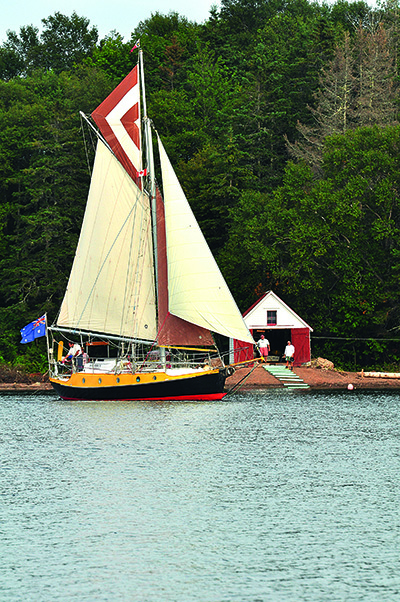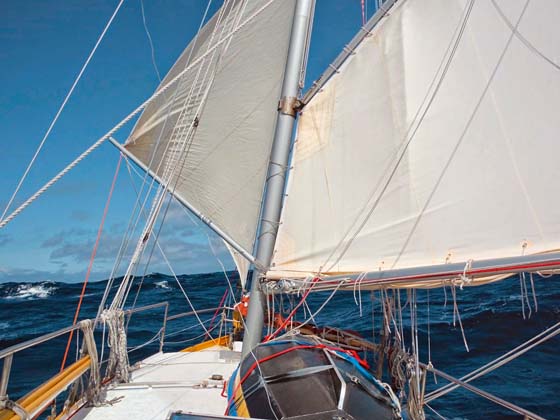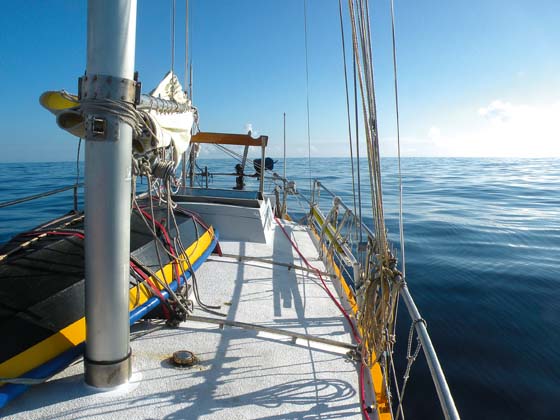On an eastward crossing of the North Atlantic solo sailor Trevor Robertson dodged Hurricane Bertha and encountered Cristobal in his gaff cutter Iron Bark. Then on the way back it was icebergs …

I moved to the Washabuck River to wait Arthur out. This is a superb hurricane hole and the wind, which caused mayhem elsewhere in Nova Scotia, hardly disturbed the mosquitoes. Hurricane Arthur departed and I hauled the anchor to leave. The windlass gave a terminal-sounding clunk and stopped. I got the anchor up by hand and sailed to Baddeck for repairs.
It took two weeks to get parts to repair the windlass and another week to sail to the south coast of Newfoundland to careen and scrub Iron Bark’s bottom. Consequently I was a month behind my original schedule when I finally set off on 2 August. Within a few hours Hurricane Bertha appeared on the forecast with a track predicted to intersect Iron Bark’s on the Grand Banks.
Again its path was further north than usual for the time of year. I altered course and anchored in Little St Lawrence, a well-protected harbour with good holding and empty except for a few skiffs.
Working across the Grand Banks
On 9 August, after Bertha had passed well to the east and gone off make mischief in Britain, I sailed with a fair wind. The breeze died within six hours and returned as a light headwind. For eight days we beat slowly into it, barely stemming the Labrador Current while working across the Grand Banks of Newfoundland, often sailing 60 or 80 miles in a day to make good less than 20 miles.
Patience is a virtue much exercised when working against wind and current in a small gaff cutter. Once off the banks the temperature rose and fog decreased, but persistent headwinds and light winds meant it remained slow going.
On 22 August, about 500 miles west of Newfoundland, I heard on the radio that a hurricane forming in the Caribbean was likely to affect Newfoundland in about a week. Most hurricanes make landfall on North America’s eastern seaboard and dissipate; a few recurve to travel east across the Atlantic, usually between 40° and 50°N. If this hurricane recurved, the safest place was north of it in its navigable semi-circle. I pushed north as quickly as I could.
Hurricane Cristobal
A week later, having made six degrees of latitude north to 54°N 29°W, a passing tanker told me via VHF that Hurricane Cristobal was now a post-tropical storm with hurricane force winds in the south-east and western sectors. It was 570 miles south-west of us and moving north-east very rapidly.

Over the next 24 hours the wind increased and backed from south-west Force 4 to east 6 with a gradually falling barometer, consistent with us being in the navigable semi-circle of a distant hurricane. I gave a provisional sigh of relief, retracted shortly afterwards when the wind veered to south-east Force 7 and the barometer started falling rapidly. There was little I could do except curse and continue north under storm jib. At least we had plenty of sea room and were out of the main North Atlantic Current.
That evening, 31 August, the wind increased to Severe Gale Force 9 from the south-east with the barometer 980mb and falling. I took in the storm jib and ran north under bare poles. I made a round of the deck, doubled the lashings on sails and dinghy and set up running backstays.
Four hours later the wind became gusty and variable and the barometer was down to 975mb. It seemed we were far enough north to have avoided the severe winds in Cristobal’s south-east sector, but still had to cross the dangerous western sector. The swell was confused, but not huge, indicating Cristobal was moving so fast that it was outpacing its own swell. This meant the seas on the far side of the centre were likely to be extremely unpleasant.
At 2245 in the space of a few seconds the wind increased to a shriek and laid Iron Bark over 40°. This was on Cristobal’s west side that I had been anticipating with dread. It was too dark to see the sea state and I do not have wind speed instruments so my estimate of the wind’s strength is tentative, but I logged it as hurricane force.
Dangerous on deck
The Aries windvane could still steer us so I set it so we ran south-east with the wind nearly astern. The sea built up quickly and broke over us often and heavily. I expected the dinghy to be crushed in its chocks or a sail to blow out of its gaskets, but could do nothing about either. Any attempt to work on deck in those conditions would be dangerous or fatal.
By dawn the shriek of the wind in the rigging had decreased slightly and the sea state was commensurate with Severe Storm Force 11. My estimate of Force 12 earlier seemed reasonable. Two hours later the wind was Storm Force 10 and was only reaching hurricane force in squalls. Conditions were unpleasant, but did not seem to be getting any worse.
Nor did they. At noon the wind was south-west Severe Gale Force 9 gusting storm force with a vile cross sea, but conditions were mild compared with a few hours earlier. We continued running south-east under bare poles at four knots. Eighteen hours after crossing the eye wall, the wind was down to Force 7. I set the storm jib and ran through the night. By dawn even the gusts were not reaching gale force. I set working lowers with the main deep-reefed and bore up for Scotland.
The rest of the passage to Scotland, which took six days, was straightforward with fair winds that never exceeded 30 knots except in the odd squall. We rounded the Butt of Lewis just after midnight on 7 September and ran down the Minch into Loch Broom and anchored off Ullapool, 29 days out from Newfoundland. If the weather had been kinder, Iron Bark could have done it in half that time.
Wrong direction
In retrospect, I chose the wrong direction to sidestep Cristobal when it atypically continued north-east instead of recurving east. If I had turned south instead of north when I first heard of the hurricane’s existence, I might have got far enough from its centre to avoid the worst weather. However, that would have put me in the dangerous semi-circle with the chance of being blown back into the hurricane’s path. I played the odds as I understood them and lost.
Chance plays a big role in really bad weather and in sustained storm force winds I think there is a real prospect that any vessel of Iron Bark’s size (35ft) could be knocked down. Keeping the vessel end-on to the dominant waves helps, but does not guarantee anything. Drogues may help, but I did not feel they were necessary in this case.
Working on deck was not feasible for about ten hours, emphasising the importance of preparation. Anything carried on deck is likely to be lost in this sort of weather and the fact that Iron Bark’s dinghy survived was merely luck.

It is a substantial clinker-built plywood affair carried inverted on heavy chocks, but one strake was stove and another wave in the right place would have reduced the dinghy to splinters. If a sail had shaken loose from its lashings it would have been shredded. To cover these eventualities I carry a spare set of lower sails and an inflatable dinghy stowed below deck.




